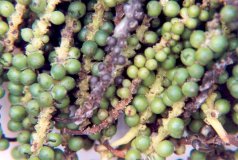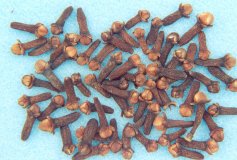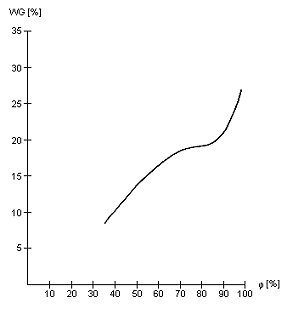The term spice is used to refer to plant parts which serve to improve the odor and flavor of foods. Spices contain essential oils and other ingredients which have a strong seasoning action.
Exotic spices mainly originate in tropical and subtropical countries and are processed, cleaned, graded and carefully packaged for overseas dispatch in the countries where they are cultivated. In consumer countries, they are delivered to spice mills, where they are cleaned and graded again and sold in unground or ground form.
Spices are classified by the plant parts used:
- Fruit and seed spices (e.g. pepper, cardamom, nutmeg) (see Fig. 124)
- Bud and flower spices (cloves) (see Fig. 125)
- Bark spices (cinnamon, cassia) (see Fig. 126)
- Root spices (ginger, turmeric) (see Fig. 127)
- Leaf spices (bay leaf) (see Fig. 128)
 |
 |
| Figure 124: Green pepper (fruit and seed spices); Photo: U. Scharnow |
Figure 125: Cloves (bud and flower spices); Photo: U. Scharnow |
 |
 |
| Figure 126: Cassia (bark spices); Photo: U. Scharnow |
Figure 127: Ginger (root spices); Photo: U. Scharnow |
 |
| Figure 128: Bay leaf (leaf spices); Photo: U. Scharnow |
Spices are dried to preserve them for transport and storage. Other preservation methods are also used for some types. After drying, the water contents of the spices amount to 8 - 23% (see Table. 19). They are thus goods with a low water content and therefore belong to water content class 2 (WCC 2).
| Type of spice | Essential oil content | Fatty oil content | Water content | |
| 1. | Fruit and seed spices | |||
| Aniseed | 2.0 - 6.0 (aniseed oil) | 10 - 12 | ||
| Cayenne pepper, Chilies |
0.5 (capsaicin) | 11 | 8 - 12 | |
| Fennel seed | 5.0 - 6.5 (fenchone, anethole) | approx. 10 | ||
| Cardamom | 3 - 8 (cardamom oil) | 2 | 10 - 12 | |
| Capsicum | 10 - 13, of which 0.15 - 0.50 capsaicin | up to 13 | ||
| Coriander | 0.4 - 1.8 (coriandrol) | max. 15 | ||
| Caraway | 2.5 - 6 (caraway oil) | up to 12 | 14 - 15 | |
| Mace | 4 - 15 (myristicin) | >20 - 30 | up to 10 | |
| Nutmeg | 6 - 10 (myristicin) | 35 - 40 nutmeg butter | up to 9 | |
| Pepper - black pepper |
4.6 - 9.7 (piperine) | 7 | 10 - 15 | |
| - white pepper | 4.8 - 10 (piperine) | 7 | 10 - 15 | |
| Allspice | 2 - 5 (allspice berry oil) | 6 - 8 | 13 - 15 | |
| Star anise | 2 - 8 (anethole) | 12.5 | 12 | |
| Vanilla | 1.5 - 3.0 (vanillin) | |||
| 2. | Bud and flower spices |
|||
| Cloves | 14 - 20 (eugenol) | 7 - 10 | 11 - 23 | |
| Saffron | 0.4 - 1.3 (saffron-bitter) | 9 - 10 | ||
| 3. | Bark spices | |||
| Cinnamon, cassia | 1 - 3.5 (cinnamon oil) | 7.8 | 12 - 15 | |
| 4. | Root spices | |||
| Ginger | 0.8 - 5 (gingerol) | max. 14 | ||
| Turmeric | 1.5 | 14 | ||
| 5. | Leaf spices | |||
| Bay leaves | 0.5 - 3.0 (cineole) | 10 - 11 |
Table 22: Oil and water contents of spices in % [28]
Their sorption isotherms form a continuous, generally S-shaped curve (see Fig. 129).
 |
Figure 129: Sorption isotherm for pepper (20°C) |
Drying interrupts the respiration processes. Spices are therefore goods which display 3rd order biotic activity (BA 3).
Spices require particular temperature, humidity/moisture and possibly ventilation conditions (SC VI) (storage climate conditions). Spices do not have any particular requirements as to ventilation conditions, if they are container dry.
Spices are transported in standard containers. Pepper and cloves present problems and for them ventilated containers (coffee containers) are more suitable, allowing dissipation of water vapor.
Packaging
Spices are very high-quality products and have to be treated with great care during transport. Packaging should provide protection in particular against exposure to moisture, mechanical damage, loss of aroma and infestation by animal pests. Jute packaging does not provide this protection, and indeed even wooden cases do not protect against insect infestation. Since all spices are more or less hygroscopic, protection from moisture is the primary consideration when selecting packaging, since moisture could lead to fermentation or mold growth. Both would permanently impair quality (aroma and flavor). The second most important consideration is protection against loss of aroma. For these reasons, very widespread use is currently made of cartons, sometimes with multiple layers of film packaging. When this virtually water vapor-tight packaging it used, it is especially important for the spices to be "container dry". During transport from hot to cold regions, the mold growth threshold (75% rel. humidity) must not be exceeded. Condensation must be prevented. If the spices do not leave the country of production suitably dry, they must be given the possibility to release moisture during the voyage, so entailing water vapor-permeable packaging. This is achieved, among other ways, by perforated film packaging and by packing in ventilated containers. Plywood chests with composite films are likewise used as packaging for spices. The composite film ensures water vapor- and aroma-impermeability and the plywood chest provides the necessary mechanical loading capacity. Despite the aroma-tightness of the packaging, it is inadvisable, and in some cases impossible, to load different spices together.
Hygroscopicity
Spices are hygroscopic goods which interact with the moisture in the air. They may on the one hand be moisture sensitive (e.g. cloves, cinnamon, bay leaves) and on the other themselves release water vapor, e.g. pepper.
The risk of mold growth is at its greatest in warm, damp air. The tendency of individual spices to grow mold depends on their hygroscopic behavior. With highly hygroscopic types (vanilla, pepper), the risk of mold attack is very great. However, in the case of vanilla it is important not to confuse the precipitated vanillin crystals with mold. Mace, for example, has a tendency to go moldy and then smell bad, so considerably impairing its quality. Cloves which have become damp are worthless, becoming grey, sticky, soft and ungrindable.
It is clear from the sorption isotherm for pepper that, at the water contents of 10 - 15% indicated in Table 22, it is at equilibrium with a rel. humidity of 40 - 55%. Water vapor release may cause it to lose several percent of its weight during a relatively long voyage. Where ventilation is inadequate, pepper becomes wet, swells and has a tendency to undergo self-heating. Container dry pepper suffers only 0.5 - 1% shrinkage.
Without ventilation in standard containers, fresh pepper can become completely worthless within a few days due to self-heating. In addition to the water content, the risk of self-heating is also explained by the relatively high content of fatty oils (see Table 22). The drying process must be complete and care must be taken during packing into the container to ensure that the product is container dry. Relative humidity should be between 60 and 70%, and over a relatively long period 75% (mold growth threshold) must not be exceeded.
Odor
The content of essential oils, which may vary for the various types of spices from 0.4% (coriander, saffron) to 20% (cloves) (see Table 22) and which, together with other constituents, e.g. fatty oils, tannins and bitter principles, determines the odor and flavor and thus quality of the spices, must be retained to the greatest possible extent. The essential oils are readily volatilized and the seasoning action of the spices is consequently reduced. Volatilization of the essential oils is primarily determined by temperature. The higher is the temperature, the more the essential oils are volatilized, as may be recognized by the intense odor in the container.
Due to the readily volatilized essential oils, most spices count as odor-emitting goods and should therefore be stowed in a container separately from each other and away from foodstuffs which readily absorb foreign odors (e.g. cloves should not be stowed with coffee or tea etc.).
On the other hand, however, spices are also sensitive to foreign odors and must not there be stowed together with odor-emitting goods. The risk of odor transmission is even greater if the spices have already been ground prior to transport (e.g. chili powder), as the enlargement of surface area associated with the grinding process gives the essential oils a greater chance of volatilizing.
Transport instructions
Standard containers stuffed with spices should be stowed below deck. The extreme temperature differences on deck of up to 60°C (between day and night) may result in container sweat. Even in winter, a sharp drop in temperature may result in container sweat. Below deck, these effects are considerably reduced. The bottom, sides and top areas in a standard container should at least be lined with packing paper. A suspended nonwoven fabric provides good protection against dripping sweat.
Ventilated containers must be stowed below deck, since they have to be actively ventilated from outside when the hatch is closed. There must be no dunnage at the sides and in the top area, since it would impair ventilation action.
Turmeric, the main ingredient in curry powder, is a dusty product causing yellow color contamination and must be handled accordingly. Vanilla, for example, is at particular risk of theft due to its high value.
Insect infestation/Diseases
Spices may be infested with animal pests, especially rats, mice, beetles and their larvae (in particular drugstore beetles, hump spider beetles, Australian spider beetles and golden spider beetles), moths (dried fruit and cacao moths) and mites. Nutmegs must not be wormy. Infested goods must not be loaded into containers and equally the containers must be free of pests. If fumigation has been performed, a fumigation certificate must be available.